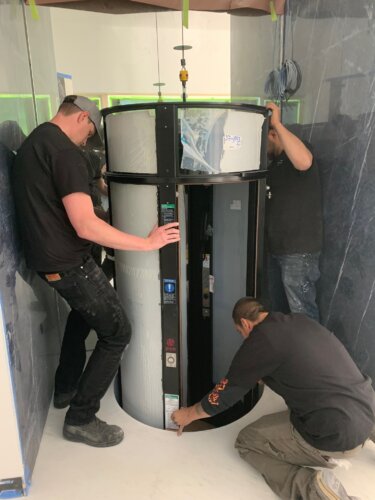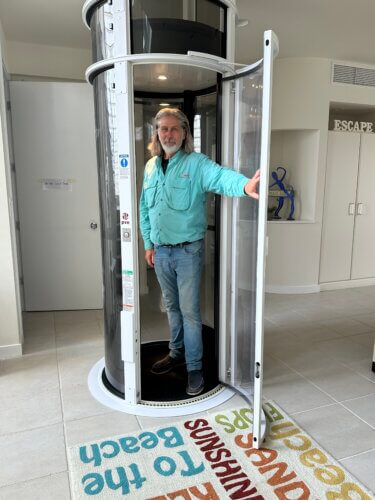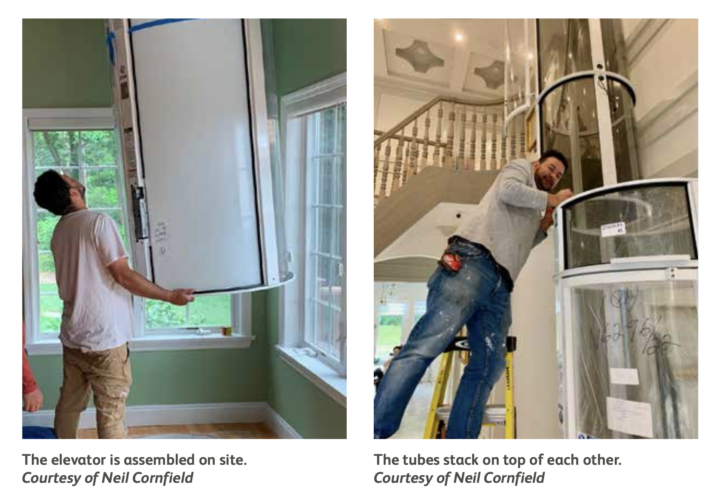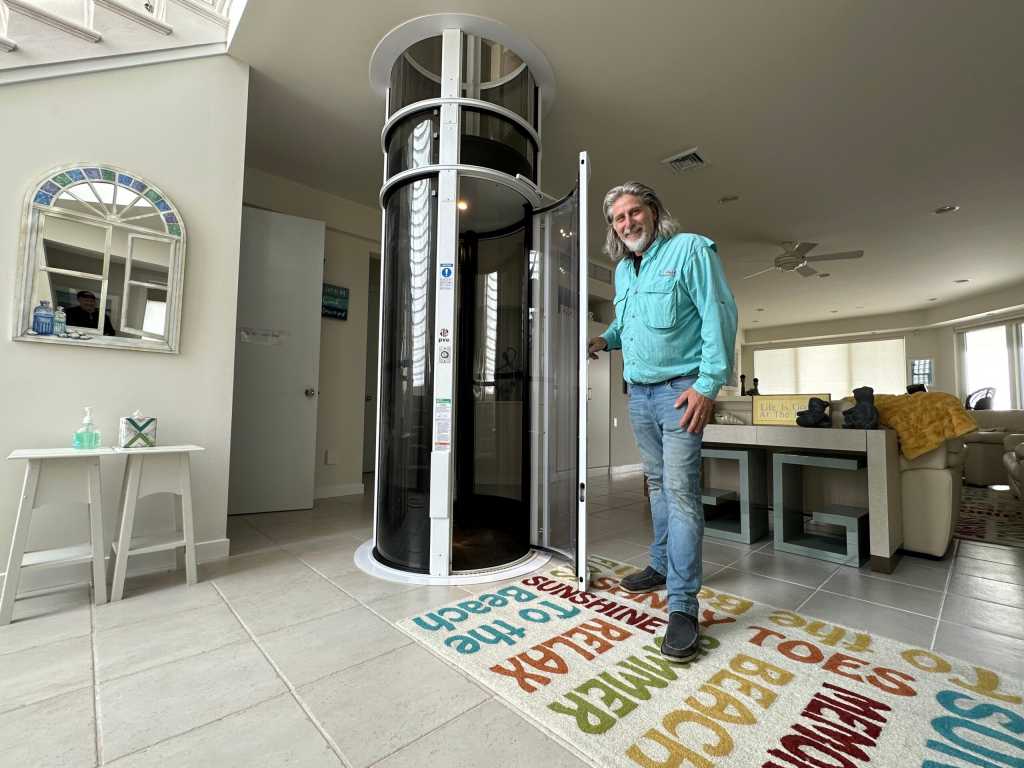Cars that drive themselves, video calls and robots cleaning our houses are all becoming part of the norm. If that all feels like The Jetsons predicted modern-day living, pneumatic vacuum elevators fit right into the residential living.
A simple, yet innovative technology, air-powered elevators can even be installed years after a house has been completed, becoming particularly popular with the older population as it offers an alternative for those who want to remain in their multiple-story homes.
“This is a freestanding elevator. It’s almost like buying a refrigerator and plugging it in. It’s that simple,” says Neil Cornfield of Custom Renovators of New York in Port Washington, a distributor and installer for the manufacturer of Pneumatic Vacuum Elevators (PVE).
“This technology has been around for 20 years, so it’s not new. It’s basically the same concept as when you’re putting money in a bank,” Cornfield says, referring to drive-thru deposit mechanisms. “Except you’re the money. It’s just the inventor changed the scale of it.”
A door opens to a panoramic tube with 360-de- gree of visibility and another to the similarly transparent steel cab that travels within the tube. The tube’s exterior is made of polycarbonate with aluminum framing. A light and a fan automatically turn on as the door opens. Once inside, a push of a button sends the elevator up or down.
Cornfield says he has found it particularly helpful for those who are thinking about the next stage in life. His consultations are usually with people who are weighing rearranging their home to make a bedroom on the ground floor or selling it altogether.
“My motto is, don’t relocate, elevate,” he says with a laugh.

“Getting old sucks. But there are realities we all face,” says Larry Dolin of Westhampton Beach. “Had we not met Neil Cornfield, and discovered his PVE elevator powered by air, we would have been forced to move. We’ve been living in our home for 40 years. The thought of being forced to leave…,” he says.
Ed Flannigan of Lloyd Harbor in Huntington also offered a testimonial for the elevator. “It allowed us to keep our home. We would’ve had to sell it if it wasn’t for Neil. The installation was non-invasive. We can even put our luggage in the elevator instead of being forced to lug it down the stairs. We have an aging population in Long Island. Because of Neil and his PVEs, so many people will be able to keep their homes.”
But, what does it cost? Depending on the size and the length of the tube based on how many floors it needs to reach and the height of ceilings, it can run anywhere between $30,000 to $70,000.

In one oceanfront house in Westhampton Beach, essentially built on pilings, the elevator was installed two years ago. It begins in the garage at the ground level and rises to both the first and second floors. The homeowner “comes in with his luggage or his groceries or whatever and goes to the kitchens on the upper floor. Basically it was a game changer for him,” Cornfield says.
There are three different sizes offered for the tube itself. The single-person elevator has a 30-inch diameter. Then a 37-inch diameter model, which was installed in the Westhampton Beach home Behind The Hedges toured, is considered a two-person elevator. Lastly, there is a wheelchair-accessible elevator with a 52-inch diameter. The elevators can hold between 350 and 525 pounds. Foldable seats are also available in the elevators.
The elevators are manufactured in the United States, assembled and tested in a factory in Miami, then disassembled and shipped for assembly in a client’s home.
The construction process goes like this: Cornfield helps his clients select the right spot for the elevator. A contractor will have to install the structural ba bracing then Cornfield will install the elevator, a process that takes about two days.
“It’s really a question of just bringing the cylinders in, stacking them up and plugging it in. It’s a plug-and-play type of elevator,” he says.
“In a contemporary home,” like this one, he says, “it becomes a showpiece.”
It is considered the most eco-friendly elevator on the market. “It uses a minimal amount of electricity when you’re coming down. All it’s doing is releasing air and gravity takes you down at a controlled speed,” he says. It also uses no harmful oils and lubricants.
The air-powered elevators also take up minimal space, whereas a conventional elevator “requires a pit, a hoist-away, cables, oils, lubricants. Though perhaps less expensive, adding the latter on after a house is complete comes with added construction costs and more room.
“Most elevator companies do not want to push this elevator primarily because there’s very little maintenance required,” Cornfield says. “A conventional elevator, by New York State law, you have to have it inspected every six months, or once a year there’s oils and lubricants and things that have to be maintained. A conventional elevator company that would normally have a maintenance contract with a client for $1,500 or $2,000 annual maintenance fee, this doesn’t have that.”
The pneumatic elevators require scheduled maintenance after 10,000 hours of continuous use.

“It took me like less than 10 seconds to come up from one floor — 10,000 hours is a long time,” he says. A seal at the top of the elevator will eventually wear due to friction, causing a slowdown in performance. “In the eight years that I’ve been doing this, I haven’t replaced one yet.”
Because some electricity is used, there is a safety mechanism built in for if there was a power failure. The elevator will slowly descend to the lower floor and the door will automatically unlock
There are other safety mechanisms. Because the elevator begins at ground level and flooding is always a possibility along the ocean, a safety switch was built in that if water is detected, the elevator will shoot right up to the second floor.
The electronics, Cornfield explains, are inside the cab and plug into a 220-volt plug at the top of the elevator, anywhere up to 30 feet away from the head of the elevator.
“Sometimes we don’t have the room on a high ceiling, so we could put the controllers in an attic,” he says.
This article appeared in the July Fourth 2023 issue. To read the full digital version of the magazine, click here. For more articles from our various magazines, click here.




















